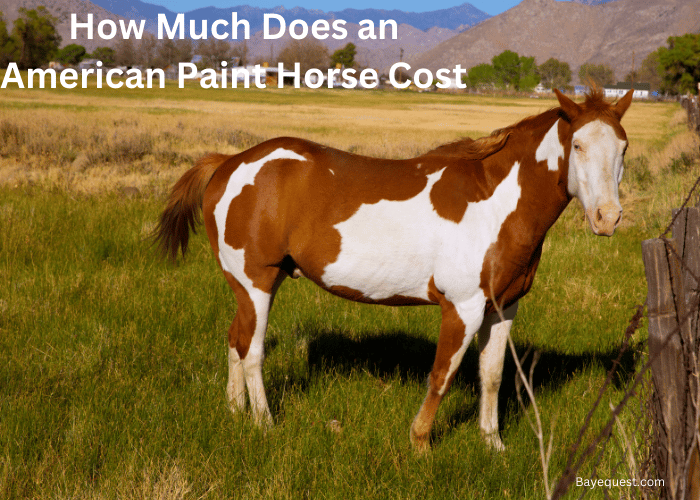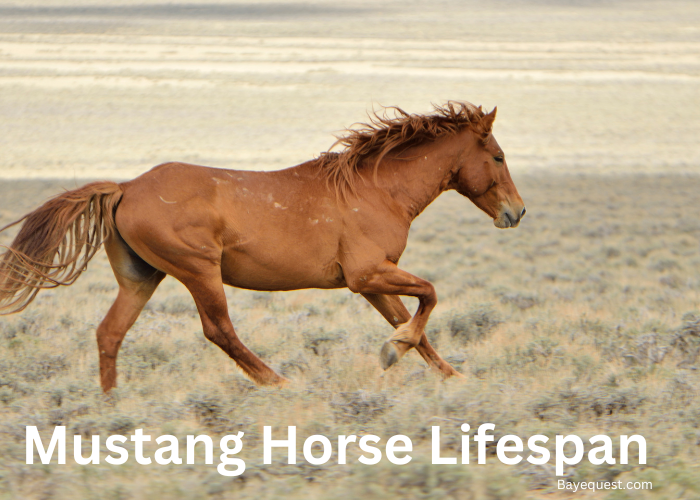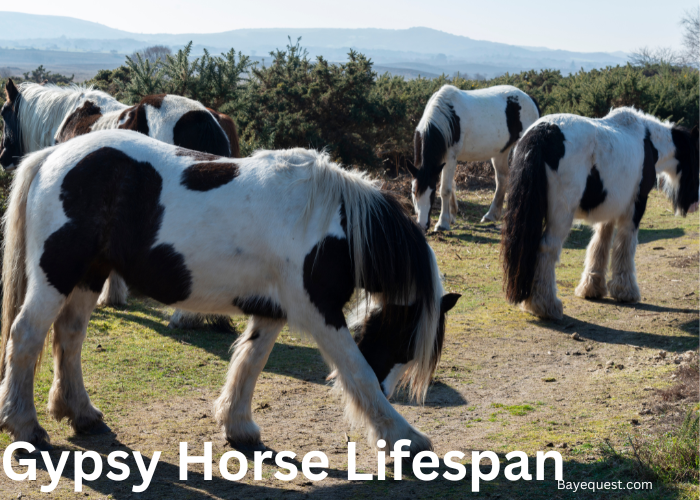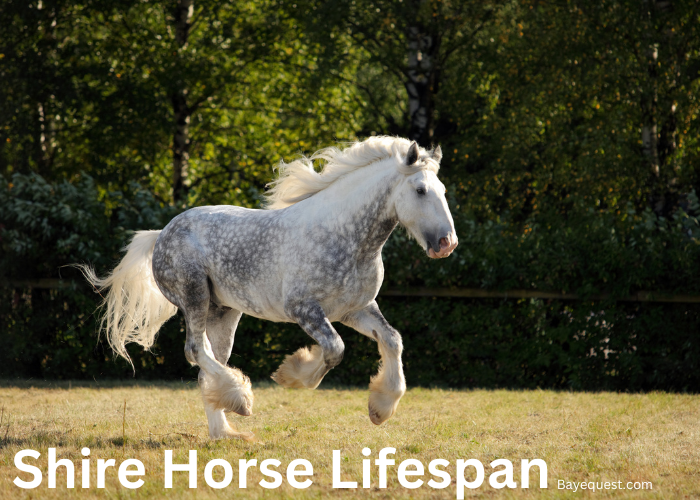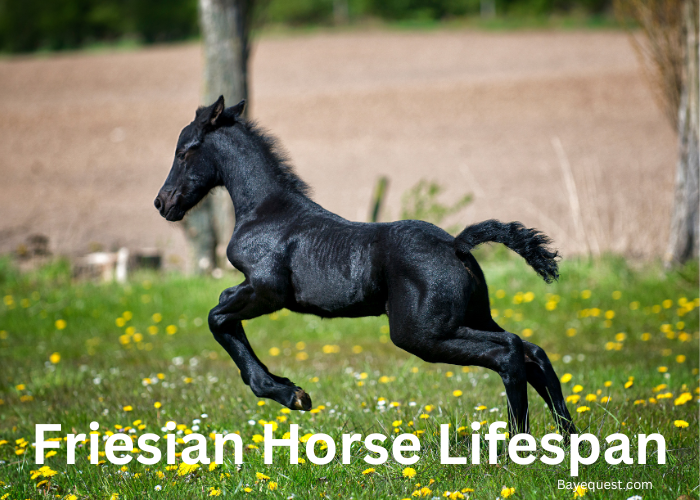Few horse breeds are more eye-catching than the American Paint Horse. Mature equines adorn spectacular patterns that stand out from the pack. The best part is that each horse has a unique pattern. Not two paints have the same coloring.
This is why paint horses are among the most popular breeds in the US. You can spot your horse from the pack with little trouble.
Fortunately, you can buy an American Paint Horse without breaking the bank. This guide explains the purchase costs and upkeep bills, including boarding and feeding expenses, to help you budget accordingly.
How Much Does an American Paint Horse Cost? Key Takeaway
The average American paint horse costs $1,000 to $5,000. It depends on the horse’s age, health, and pedigree. Young foals under four and older veterans over 25 years are the cheapest, typically costing under $3,000. Meanwhile, mature equines in their prime rarely cost less than $5,000.
American Paint Horse History and Origin
American paint horse origins can be traced back to North Africa and Asia Minor (modern-day Turkey). These athletic, two-toned horses had many descendants roaming the plains and valleys alongside buffalos and other wild animals.
Later, Spanish explorers captured and brought a few to North America. Then they gradually tamed them and improved their conformation over many decades. Next, they crossed them with thoroughbreds and American quarter horses, producing some of the finest drivers and pleasure riders.
Interestingly, the colorful skins have persisted. Every horse has a unique pattern with attractive spots that breeders and owners adore.
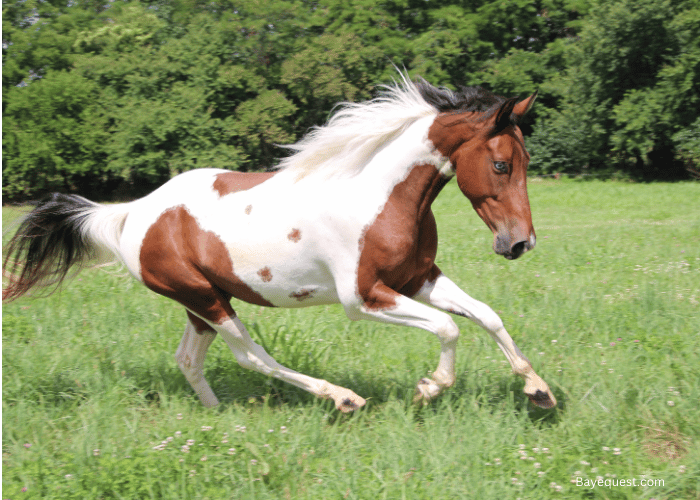
American Paint Horse Characteristics
The American paint horse is a medium-sized, athletic horse that conquers most disciplines. Here’s how to recognize one;
- Size: The average American paint horse is 14.5 tall, though a paint stallion can reach 16 hands. This makes them medium-sized horses, bigger than ponies but smaller than draught horses. Thus, they are great for all types of riders.
- Weight: American paint horses weigh between 950 and 1200 pounds. This is the same as the average American quarter horse. However, paint horses from thoroughbred bloodlines are slightly bigger.
- Color: No two horses from the paint family have the same coat pattern. Moreover, the American Paint Horse Association (APHA) strictly defines the color combinations. According to APHA, the paint horse is white, with any other color(s) from the equine rainbow. The four most common patterns are tovero, overo, tobiano, and sabino.
Why Buy An American Paint Horse Breed?
Breeders and owners love the paint horse for many reasons. Here’s why you should consider one, too;
- Aesthetic advantages: The paint is among the most beautiful horses. They mostly come in unique, eye-catching coat patterns like tovero, overo, palomino, and sabino. Additionally, it’s a fine-shaped stock horse with well-defined features.
- Great for beginners: The American paint horse is a gentle, friendly horse, perfect for beginners. They tolerate beginner mistakes without making a fuss.
- Ideal for children: The docile, intelligent paint horse is a wonderful companion for kids. They also make exceptional pets.
- Great size for all riders: The paint horse’s medium size fits riders of all statures. This is much more comfortable than draft breeds, which can be intimidating for shorter riders.
- Versatility: The paint horse is a highly versatile horse that thrives in multiple disciplines. You can use them on the farm and hunting expeditions. But they are equally adept at shows, events, racing, and rodeos.
- Affordability: Despite their versatility and exceptional temperament, paint horses are highly affordable. In most states, a healthy, mature stallion or mare costs less than $5,000.
How Much Does an American Paint Horse Cost?
The average American paint horse price is $1,000 to $5,000. That’s the asking price in most markets and auctions.
However, the buying prices vary significantly, depending on your location, the horse’s qualities, and your negotiation skills.
For example, there aren’t as many horses in Hawaii as in Delaware. Therefore, Hawaiian sellers must ship their stock from other states. This alone pushes the asking prices substantially. Also, the state’s cost of living impacts prices.
Meanwhile, the horse’s qualities include age, gender, size, bloodline, training, and show records.
Generally, your horses are cheap. A few breeders even give out weanlings for free seasonally.
Aged veterans are also cheap. But stallions and mares at their peak (6-15 years) are expensive.
The bloodline is vital because it determines the horse’s potential. For example, foals from a lineage of championship winners are highly prized.
You’ll also pay more for trained horses. The additional costs depend on the type and level of training, but it can run into thousands.
For example, a 9-year-old gelding with 3+ years of experience in equine dressage or showjumping costs $15,000+.
Finally, many equestrians love equine shows and events. A few even dream of owning championship winners.
It’s all fine. But be prepared to pay more. Typically, owners ask for $30,000+ for event-winning paint horses.
See also: Cheapest Horse Breed in the World.
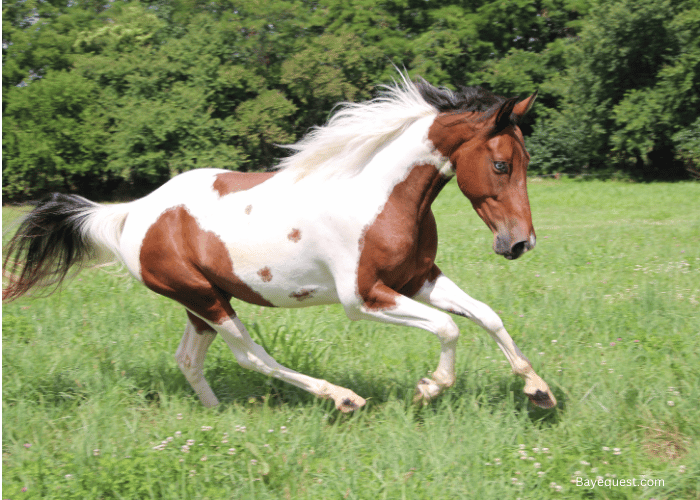
American Paint Horse Cost Breakdown
You’re probably wondering about the ownership costs. It’s not cheap. You’ll likely spend $10,000/year to keep the horse. Let’s break down the upkeep costs to help you plan better.
Purchase Price
Buying the horse is the biggest upfront cost. Most sellers ask for $3,500 for a mature paint horse. But you can find a few for $2,500 or $,3000.
Unfortunately, most sellers expect the full amount upfront. A few breeders accept partial payments. But owners often sell to whoever pays the asking price upfront. This further complicates the process as many buyers, especially first-timers, prefer trial periods. So, plan accordingly.
One option is to get referrals from family and friends. Alternatively, ask for an agreement and guarantees to protect your investment.
Boarding Costs
After buying the horse, you must immediately decide whether to keep them at home or at a commercial boarding facility. Both are workable. But each has pros and cons.
Keeping the horse on your property is cost-effective. You can save thousands on forage and boarding charges yearly. However, it’s laborious. On a bad day, you’ll spend hours in the barn. Also, you must watch the horse round the clock, lest they cause trouble.
Boarding facilities save you the trouble, but a cost. Moreover, not all horse boarding plans are the same. Self-care and pasture boarding, though cheap, leave most care duties to the owner. Meanwhile, full-service boarding costs $600-$2,000 monthly, which is beyond most owners’ range.
Accessories and equipment
Accessory and equipment costs depend on the boarding plan. Full-service boarding facilities provide nearly every accessory and equipment to handle the horse. They’ll even send a truck to pick up the horse.
Meanwhile, self-care and pasture board plans only provide the basics. The owner delivers the rest. For instance, the owner must purchase the horse tack and feeding equipment separately under a self-care program.
So, you must plan accordingly, as the horse tack alone costs $200 to $2,000. Reuse accessories and equipment from previous horses to save costs. Also, consider second-hand equipment from eBay and other marketplaces.
Feeding Costs
A healthy horse consumes 2% of their weight in hay alone. Thus, the average paint horses consume (2/100) *950 pounds. This comes to about 20 pounds of hay daily.
You can easily calculate the monthly and yearly costs. A quick Google check shows hay costs $3 to $7 per 50-pound bale, depending on the quality. This means an average 50-pound bale costs $5, thus 20 pounds cost $2. That’s $60/month or $720/year.
In addition, paint horses require salts and supplements to grow strong and healthy. A $2/day budget is sufficient, translating to another $720/year. Thus, the total cost of feed is around $1,440/year.
Vet Care and General Hygiene
Healthy equines live the longest. Also, good health allows the horse to reach their full potential while giving the owner maximum peace of mind. But it costs substantial amounts to achieve optimal health.
First, regular care is a must. Most vets charge $150/visit, and you need to schedule one every 2-3 months. This totals $300 to $450 yearly. Next, horses require regular deworming and vaccination. Thankfully, you only need 2-3 sessions yearly. But each session costs $50 to $150. So, it’s another $200 to $1,200 per year.
Additionally, you must budget for farrier services and dental work. Each of these costs $200-$$1,000 per year, depending on the quality of care. Thus, you’re looking at $2,000 to $2,500 in medical bills yearly before accounting for emergencies such as the lethal white syndrome.
Other Expenses
Three other costs to remember when buying a horse are the registration charges, show expenses, and training costs.
Registration costs are unavoidable because your horse is only a paint when you register with the American Paint Horse Association (APHA). Unfortunately, the association charges up to $500 to register a horse. In addition, APHA has special membership plans that cost up to $119/year.
Meanwhile, equine shows and events are optional. However, they can be highly beneficial to the horse and the owner. You may even earn from your participation. But entry costs $50 to $200 in most cases. Additionally, you must budget for costumes and transportation.
Finally, horse training is invaluable but costly. Basic training costs $200/month, while special training costs up to $2,000/year.
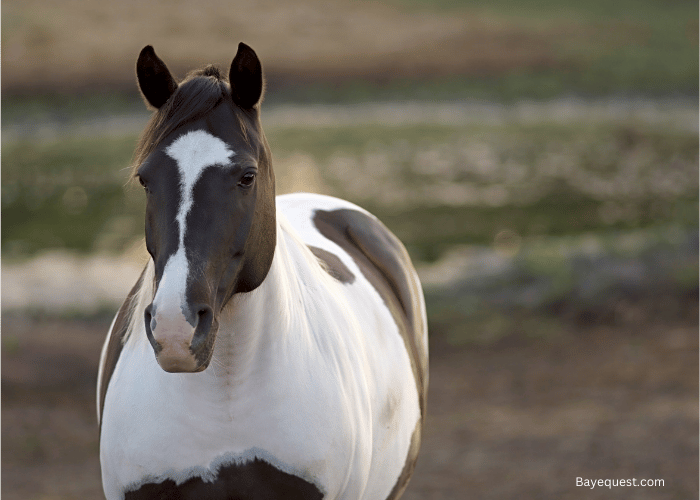
What’s the Most Expensive Paint Horse in History?
The most expensive American paint horse to date is Mark This Roscinate. Mark Teel from Oklahoma bought the tobiano stallion for a record $33,000. But the ranch and reigning horse has since won multiple championships.
Read also: Difference Between Paint and Pinto Horse.
Where to Find Paint Horses for Sale
Finding the right American paint horse is easier said than done. So, you should deeply think about your options before you set out on a search.
First, ask around. There’s a chance someone in your circles has one or knows someone who does. You’ll likely get a better price than buying in the open market. Moreover, trust is everything in the equine world. So, a seal of approval from a friend or family makes all the difference.
Contact the American Paint Horse Association (APHA) if plan A fails. The association has over 41,000 members and registers about 10,000 new paint horses yearly. So, it’s the perfect place to find the right seller. You may also check with the Stock Horse Association.
Next, consider local breeders and horse owners. You may need to ask around. But they have some of the best prices.
Finally, consider online and offline markets. Auctions are the most common and happen online and offline regularly. However, you can also check Google and social media platforms to discover seller websites and pages.
Tips When Buying An American Paint Horse
Shopping for a horse is a complex process, especially for first-timers. Consider the following tips to avoid common pitfalls;
- Have a budget and stick to it: Outline your goals and decide how much you will spend to attain them. For instance, pet horses don’t have to be expensive. You can easily get a weanling for under $1,000.
- Seek expert help: Assessing horses requires a keen eye. Otherwise, your horse may even fail APHA coat pattern requirements. So, seek assistance from an experienced trainer and licensed vet.
- Ask for the records: Health, training, and show records are the most important. They give you a starting point when caring for the horse. A breeder may also want records to verify the horse’s ancestry and bloodline.
- Shop around and negotiate: Speak to several sellers to determine the going rates. Then, pick the best seller and negotiate the price. Ideally, start your negotiations at 75% of the asking price and try to close the deal at least 15% below the asking price.
- Sign a sale agreement: Sale agreements outline the sale details, including the price, date, witnesses, and the horse’s condition at sale. It also includes each party’s concessions and commitments. You need it in case of issues down the line.
American Paint Horse Alternatives
Most equestrians compare the American paint horse to the quarter horse and Appaloosa. Paints and quarter horses have the same foundation breed and a striking resemblance. Indeed, the quarter horse registry sometimes accepts paint horses and vice versa. It depends on the degree of white coloration.
Similarly, some paint horses closely resemble the Appaloosa breed. The colors can be very close. However, Appaloosas have a leaner build with an angular head. Meanwhile, the paint horse is stockier, with a refined head.
FAQs
What qualifies a horse to be a paint?
To be considered a paint horse, the equine must first register with the American Paint Horse Association (APHA), the American Paint Quarter Horse Association
(AQHA), or the Thoroughbred (TB) registry. Also, the horse must pass the paint-horse color requirements under APHA guidelines.
Are paint horses good for beginners?
Yes, the American paint horse breed is great for beginners. They are calm, friendly, loyal, and happy to meet the owner. Moreover, paint horses are excited to go on a walk or ride. Beginners can also benefit from their intelligence and trainability.
What are paint horses mainly used for?
The American paint is a stock horse. Stock horses are primarily bred to work long days on farms, plantations, or rough terrain. Additionally, the paint horse makes a great ranch worker and trail rider. Besides manual labor, paint horses excel in rodeoing, reigning, showjumping, and pleasure riding.
What’s the American Paint horse lifespan?
The American Paint horse lifespan is 31-32 years, depending on health and working conditions. However, a few paints live well past that. For example, the oldest paint horse on record is the tobiano chestnut named Kurrabi Karma. Foaled in 1981, she’s 43 years old in 2024.
Summary
A registered paint horse costs $1,000 to $ 5,000. Mature geldings are the most expensive at $5,000+, while foals between 1-5 years cost $1,000 to $3,000. However, well-acclaimed paint horses cost $10,000+. Scrutinize the health and training records to verify the seller’s claims.




